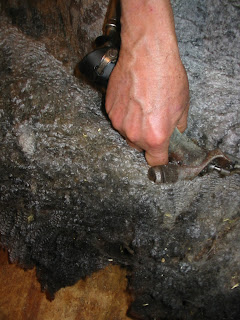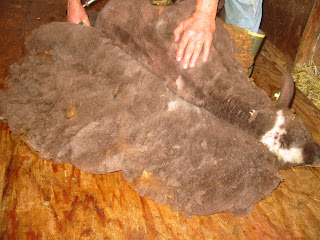Gooseberry, looking rather startled at recent developments...
...and being separated from her fleece.
Wabbit says, "He calls himself a professional, but look at this dorky hair!"
Peaches has faded to a wonderful shiny silver.
Copper has faded in an interesting mottled fashion.
The difference in fleece types is pretty wide here. We have the finer wools, like Sunny. Under her coat her fleece naturally separates into blocky, upright sections of wool. There doesn't seem to be much rhyme or reason as to how the wool separates. Some blocks are big, some are little. But if you look closely you'll see that the bigger sections have creases where they could easily separate into smaller blocks. The smaller pieces - maybe the thickness of your finger - would be considered a lock. Imagine how chaff and crap would creep down in between the locks and make the wool trashy without the benefit of a coat.
Sunny, coat off.
Sunny, also with some interesting mottling, having that fleece peeled off.
Compare that to Alexandria the Cotswold. Cotswolds have coarse wool. I hate that term which makes it sound like the fiber feels scratchy and nasty but it really just means that each fiber is fatter in diameter than most other breeds. Cotswold wool fibers usually measure 30 to 40 microns in diameter. Fine Merino is about 18 to 20 microns. A red blood cell measures 8 microns. So saying Cotswold is 'coarse' is all relative. Anyway, her wool divides itself into very distinct locks. While a little chaff sticks in it, the lock structure is such that a good shake makes most stuff fly off. (Having good hay feeders helps too!)
Alexandria's locks - an "open" fleece, and naturally curly.
Here's a good list of sheep breeds and their micron counts, and here's a discussion of why you should care.
More naked sheep Thursday! Stay tuned!








Great post! Beautiful fleeces...of course. Or should I say Of Coarse? Love those pretty Cotswold curls.
ReplyDeleteInteresting. I didnt realuze there were so much difference.
ReplyDeleteBeautiful wool!!!
ReplyDelete